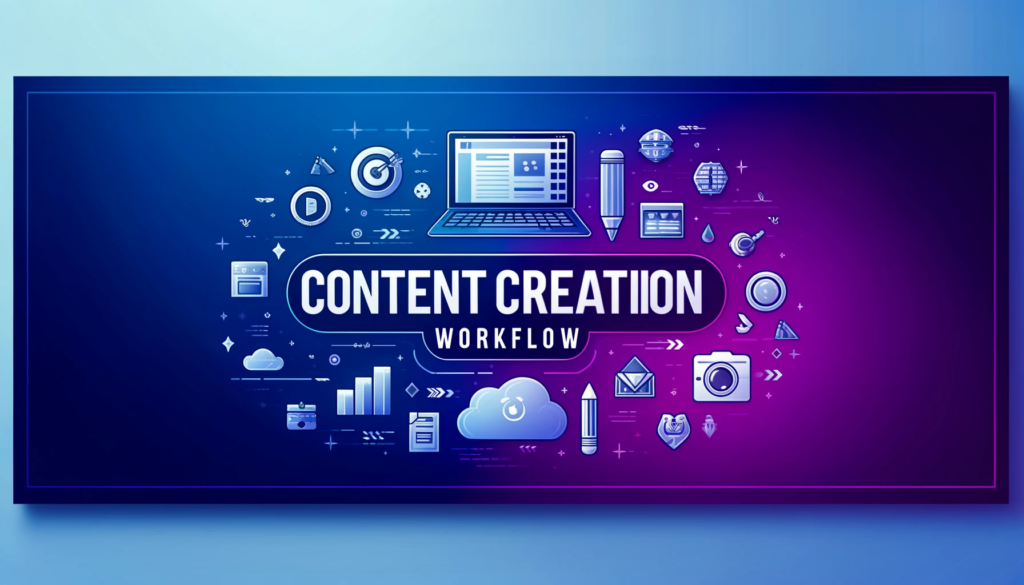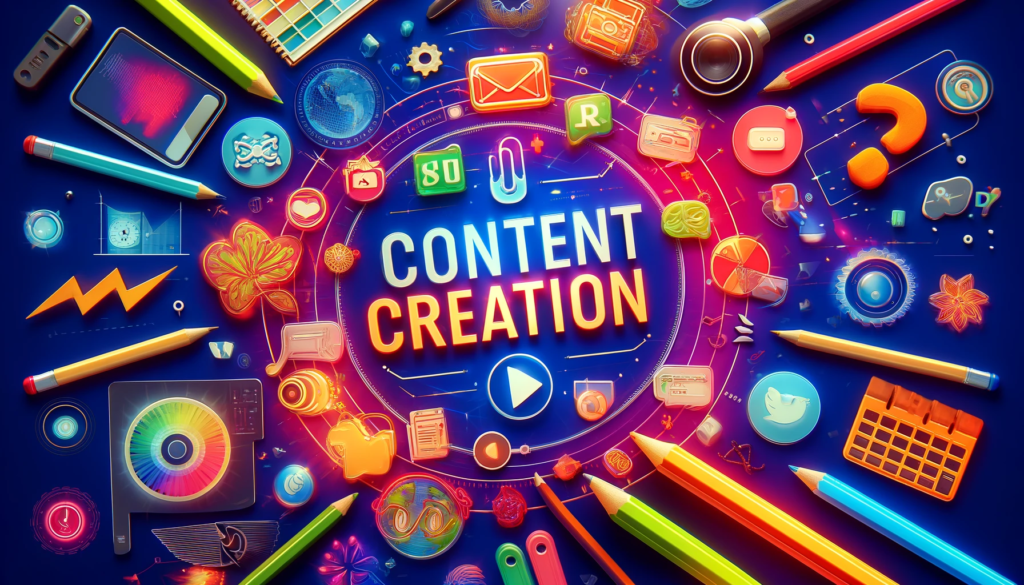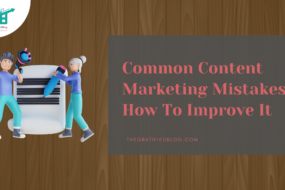
Content creation is an intricate and multifaceted process that involves various steps, from ideation to publication. Whether you are a solo content creator, part of a digital marketing agency, or managing a team, a streamlined content creation workflow is crucial for consistently producing high-quality content. This blog, “What step should you always incorporate into your content creation workflow?” will walk you through the comprehensive steps of an effective content creation workflow, ensuring you can create impactful content that resonates with your audience.
What is Content Creation Workflow?

A content creation workflow is a structured process that guides content production from ideation to publication. It involves several stages: brainstorming and planning, where ideas are generated and outlined; creation, where the content is written, designed, or recorded; editing and revisions to ensure quality and accuracy; approval, where stakeholders review and approve the content; and finally, publishing and distribution to the intended audience. Effective workflows streamline collaboration, ensure consistency, and maintain deadlines, enhancing productivity and the overall quality of the content produced.
What Are The Benefits Of Content Creation Workflow?

A Content Creation Workflow offers numerous benefits, particularly for digital marketing agencies and content-driven businesses. Here are the primary benefits:
- Improved Efficiency: A structured workflow streamlines content creation from ideation to publication, saving time and reducing redundancy.
- Consistency: It ensures consistent output in terms of tone, style, and quality, which is crucial for brand recognition and trust.
- Better Collaboration: A clear workflow helps team members understand their roles and responsibilities, facilitating smoother collaboration and reducing misunderstandings.
- Enhanced Quality Control: A defined workflow includes stages for reviewing and editing, which helps identify and correct errors before publication, ensuring high-quality content.
- Resource Management: Better allocation and utilization of resources, ensuring that tasks are completed on time without overburdening any team member.
- Scalability: As the content demands grow, a well-established workflow can easily scale, accommodating increased volume without compromising quality.
- Measurable Results: It facilitates tracking performance metrics, helping analyse what works and what doesn’t, leading to continuous improvement.
- Creative Freedom: By streamlining operational tasks, creators can focus more on the creative aspects, fostering innovation and creativity.
- Strategic Planning: A workflow supports strategic planning, ensuring content aligns with overall marketing goals and business objectives.
- Risk Management: It helps identify potential risks and bottlenecks early in the process, allowing for proactive management and mitigation.
- Improved Accountability: Clear workflows define responsibilities and deadlines, improving accountability within the team.
Why Marketers Need a Content Creation Workflow?

A well-structured content creation workflow is essential for marketers to ensure consistent, high-quality output and efficient use of resources. Here are several key reasons why:
1. Consistency in Content Quality
- Brand Voice and Style: A standardized process helps maintain a consistent brand voice and style across all content, reinforcing brand identity and trust.
- Quality Control: Regular checkpoints for review and editing ensure that content meets quality standards before publication.
2. Efficiency and Productivity
- Streamlined Processes: Clear steps and responsibilities reduce time wasted on unnecessary revisions or miscommunication.
- Task Management: Assigning specific tasks to team members ensures that everyone knows what they need to do and avoids bottlenecks and delays.
3. Better Planning and Strategy Execution
- Content Calendar: A workflow typically includes a content calendar, helping teams plan and publish content in alignment with marketing campaigns and key dates.
- Goal Alignment: Structured workflows ensure that each piece of content aligns with broader marketing goals and strategies, improving overall effectiveness.
4. Scalability
- Growing Teams and Output: As teams and content demands grow, a well-defined workflow makes it easier to onboard new team members and increase content production without sacrificing quality.
- Automation Opportunities: Clear processes can highlight areas for automation, further improving efficiency and allowing teams to focus on more creative tasks.
5. Data-Driven Improvements
- Performance Tracking: A workflow often includes mechanisms for tracking content performance, providing insights into what works and what doesn’t.
- Continuous Improvement: Regular analysis of content performance data allows for ongoing refinement of the content creation process.
6. Collaboration and Communication
- Cross-Functional Collaboration: Effective workflows facilitate collaboration between different departments (e.g., marketing, design, SEO), ensuring all necessary expertise is integrated into the content.
- Feedback Loops: Established feedback processes improve communication and allow for quick adjustments based on input from various stakeholders.
7. Risk Management
- Compliance and Legal Checks: Including stages for legal and compliance reviews helps avoid potential legal issues or brand missteps.
- Crisis Management: A well-defined workflow includes protocols for handling content-related crises, ensuring quick and appropriate responses.
What Step Should You Always Incorporate Into Your Content Creation Workflow?
A well-structured content creation workflow helps streamline the process and ensures consistency, quality, and effectiveness. Let us explore the steps you should incorporate into your workflow to ensure your content stands out in a crowded digital space.
Ideation: Generating Content Ideas
Understanding Your Audience
Before you start generating content ideas, it’s essential to understand your audience. This involves creating detailed buyer personas that include demographic information, interests, pain points, and behaviour patterns. Understanding your audience helps you create relevant and engaging content.
Brainstorming Sessions
Organize brainstorming sessions with your team to generate a pool of content ideas. Use techniques like mind mapping, free writing, or the SCAMPER method (Substitute, Combine, Adapt, Modify, Put to another use, Eliminate, and Reverse) to stimulate creative thinking.
Competitor Analysis
Analyze your competitors’ content to identify gaps and opportunities. Tools like BuzzSumo can help you see which types of content perform well in your industry. Look for topics that haven’t been covered extensively or that you can approach from a unique angle.
Keyword Research
Conduct thorough keyword research to identify topics that your audience is searching for. Use tools like Google Keyword Planner, Ahrefs, or SEMrush to find keywords with high search volume and low competition. This will help you optimize your content for search engines and drive organic traffic.
Content Calendar
Create a content calendar to plan and organize your content ideas. This calendar should include the type of content, the target audience, the publication date, and the responsible team members. A well-structured content calendar ensures a consistent posting schedule and helps manage deadlines.
Research and Planning
In-Depth Research
Once you have a content idea, conduct in-depth research to gather relevant information, statistics, and insights. This may involve reading articles, whitepapers, research studies, and industry reports. Verify the credibility of your sources and keep track of your references for citation.
Outline Creation
Create a detailed outline for your content. This should include the main points, subheadings, and key takeaways. An outline serves as a roadmap for your content, ensuring that you cover all the necessary points in a logical and coherent manner.
Setting Goals and Objectives
Define clear goals and objectives for your content. Are you aiming to educate, entertain, or persuade your audience? What action do you want your readers to take after consuming your content? Setting specific goals helps in measuring the effectiveness of your content.
Content Creation

Writing
Start writing your content based on the outline you have created. Focus on delivering value to your audience by providing actionable insights, practical tips, and engaging storytelling. Use a conversational tone to make your content more relatable and engaging.
Visual Elements
To enhance your content, incorporate visual elements such as images, infographics, charts, and videos. Visuals not only make your content more appealing but also help convey complex information in an easily digestible format.
SEO Optimization
Optimize your content for search engines by incorporating relevant keywords, optimizing meta tags, and using internal and external links. Ensure your content is structured with proper headings and subheadings and includes alt text for images.
Editing and Proofreading
Thoroughly edit and proofread your content to eliminate grammatical errors, typos, and inconsistencies. Tools like Grammarly and Hemingway can assist in enhancing the readability and quality of your content. Additionally, consider getting a second pair of eyes to review your content for any overlooked errors.
Review and Approval
Internal Review
Conduct an internal review of your content by sharing it with team members for feedback. This helps identify areas that need improvement and ensures that the content aligns with your brand voice and messaging.
Client Approval
If you create client content, send the draft for their review and approval. Be open to their feedback and make necessary revisions to meet their expectations and requirements.
Compliance Check
Ensure that your content complies with legal and regulatory guidelines. This is particularly important for healthcare, finance, and legal industries, where strict regulations apply.
Publishing
Formatting and Design
Format your content for the platform where it will be published. This may involve adding headings, bullet points, and hyperlinks and ensuring that the design elements are consistent with your brand’s style guide.
Scheduling
Use content management systems (CMS) or scheduling tools to schedule your content for publication. Tools like WordPress, HubSpot, and Buffer can help you manage your publishing schedule and automate the posting process.
Cross-Promotion
Promote your content across multiple channels to increase its reach and visibility. Share it on social media, email newsletters, and other relevant platforms. Collaborate with influencers and partners to amplify your content’s reach.
Performance Analysis
Analytics and Metrics
Track the performance of your content using analytics tools like Google Analytics, HubSpot, or SEMrush. Monitor key metrics such as page views, engagement, click-through, and conversion rates to evaluate their effectiveness.
Audience Feedback
Collect feedback from your audience through comments, surveys, and interactions. This helps you understand their preferences and identify areas for improvement.
Continuous Improvement
Refine your content strategy using insights from performance analysis and audience feedback. Experiment with new formats, topics, and techniques to continuously improve your content creation process.
Repurposing Content
Updating and Repurposing
Repurpose your existing content to extend its lifecycle and reach a broader audience. This can involve updating old blog posts with new information, turning articles into videos or podcasts, and creating snippets from long-form content.
Content Syndication
Syndicate your content to other platforms and websites to increase its visibility. This can involve guest posting, submitting articles to industry publications, or collaborating with content aggregators.
Evergreen Content
Focus on creating evergreen content that remains relevant and valuable over time. This type of content attracts traffic and engagement long after its initial publication.
Frequently Asked Questions
Q1. What are the steps of content creation?
Ans. Content creation involves several key steps: First, identify your target audience and research their interests and needs. Next, brainstorm and plan content ideas to align with your brand and goals. Create a calendar to organize and schedule your posts. Develop the content, focusing on quality and engagement. Use SEO best practices to optimize your content for search engines. Review and edit to ensure accuracy and coherence. Publish the content on the appropriate platforms and promote it through various channels. Finally, analyze performance metrics and feedback to refine and improve future content.
Q2. What are the 5 steps for the content creation framework?
Ans. The content creation framework involves five essential steps. First, conduct thorough research to understand your audience and identify relevant topics. Next, plan your content by outlining key ideas and structuring your message. Create the content, ensuring it is engaging, informative, and aligned with your brand voice. Then, review and edit to ensure accuracy, clarity, and consistency. Finally, publish and promote your content through appropriate channels, analyzing performance metrics to refine future content strategies. This structured approach helps maintain quality, relevance, and effectiveness in content marketing efforts.
Q3. What is a content creation workflow?
Ans. A content creation workflow is a systematic process for producing, managing, and distributing content. It begins with ideation, where topics and themes are brainstormed. Next, research and planning are conducted to ensure relevant and valuable content. The creation phase involves writing, designing, or recording the content. After creation, the content undergoes editing and revisions for quality assurance. Once finalized, the content is published on appropriate platforms. The workflow concludes with promotion and distribution to reach the target audience, then analyzing performance metrics to inform future content strategies. This streamlined approach ensures efficiency and consistency in content production.
Q4. What are the 3 stages of content creation?
Ans. The three stages of content creation are planning, creation, and distribution. Planning involves researching the target audience, defining objectives, and brainstorming ideas. In the creation stage, the content is produced, whether written, visual, or audio. This includes drafting, editing, and refining to ensure quality and alignment with the brand’s voice. Distribution is the final stage, where the content is shared through various channels such as websites or email campaigns. This stage also involves tracking performance metrics to measure the content’s effectiveness and inform future content strategies.
Q5. What are the 5 steps of content development?
Ans. Content development involves five key steps. First, research your audience to understand their needs, preferences, and pain points. Next, plan your content strategy by defining your goals, topics, and content types. Then, create high-quality, engaging content that aligns with your strategy and resonates with your audience. After creating the content, distribute it across appropriate channels to reach your target audience effectively. Finally, measure and analyze the performance of your content using analytics tools, making adjustments as needed to improve future content and achieve your goals.
Q6. What are the steps of content process?
Ans. The content process involves several key stages. It begins with research to understand the target audience and their needs. This is followed by planning, where topics and formats are decided. Content creation comes next, involving writing, designing, or producing the content. After creation, the content undergoes proofreading to ensure quality. The next step is distribution, where the content is shared through appropriate channels. Finally, performance is analyzed to measure effectiveness and inform future content strategies. Throughout, feedback loops help refine and improve the process continuously.
Conclusion
An effective content creation workflow is essential for producing high-quality content that resonates with your audience and achieves your business goals. By following the steps outlined in this blog, you can streamline your content creation process and ensure consistency, efficiency, and success. Whether you are a solo creator or part of a team, a well-structured workflow will help you navigate the complexities of content creation and deliver impactful content that stands out in today’s competitive landscape.
In conclusion, remember that content creation is a dynamic process that requires continuous learning and adaptation. Stay updated with the latest trends, tools, and techniques to keep your content fresh and relevant. By investing time and effort into planning, creating, and analyzing your content, you can build a strong content strategy that drives engagement, builds trust, and achieves your business objectives.








No Comments